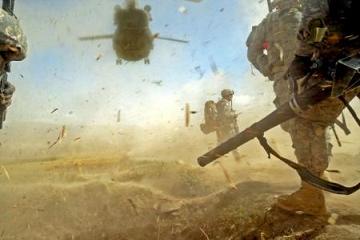US-NATO Occupation Forces in Afghanistan: Pullout or Chased Out?

Foreign occupation troops in Afghanistan are caught between an anticipated withdrawal and an expected rout.
TWO days ago, Nato came to an inevitable conclusion: start handing control of Afghanistan back to the Afghan people later this year. That was the thrust of the Nato meeting in Tallinn, Estonia, during the week.
The eventual pullout might not have been part of the original plan when US forces invaded and ejected the Taliban regime in 2001. After all, Afghans live in a strategic region with layers of intrigue overlaid with oil pipelines in or around Central Asia, the Caspian, and certain transnational corporations running through some nations while bypassing others.
Oil as a geopolitical factor has been as influential as it has been invisible, and the Bush administration that invaded Iraq and Afghanistan has been the most informed by oil interests yet. Besides, like Saddam Hussein’s Iraq, Taliban Afghanistan had posed as such a convenient and tempting target when they refused to “cooperate” quietly.
Nonetheless, a projected winding down of US-led occupation forces later this year accords with US President Barack Obama’s plan to withdraw US troops from July 2011. Officially, this would first need to be approved by the Afghan government this July.
However, the proposed schedules are still very tentative when seen from either the Nato or the US standpoint. Realities on the ground indicate that various militant groups in Afghanistan or in neighbouring Pakistan are regrouping, and raring to “test” local government strength once the occupying forces withdraw.
Equally, the presence of foreign forces does not discourage militant attacks on them or on local villagers in the way. The status of foreign troops as occupiers only affirms their role as legitimate targets, for nationalistic, religious, local political or some self-interested purposes.
Then when the occupation forces retaliate against suspected insurgent hideouts, innocent bystanders often get maimed or killed as well. Militant groups and local communities have different reasons for ridding their country of foreign occupiers, that being a hallmark of Afghan history.
Such are some of the undercurrents of the occupation that the foreign forces have had to improvise to stay ahead, or just stay alive. This constant need to evolve policy in the field is crucial, albeit seldom appreciated in central headquarters in Washington.
The latest need involves deciding the future of small, remote military outposts that come under frequent militant attack. These attacks resulted in the troop withdrawal from Korengal Valley in mid-April, and now the issue is whether to maintain positions like Combat Outpost (COP) Spera in eastern Khost province.
Militant attacks usually involve a mutual exchange of fire with some casualties, without the insurgents defeating the occupation troops. But the larger questions are how long these outposts can continue to endure a war of attrition, and whether remote outposts are worth the trouble.
Operationally, the militants know where the occupation troops are, but not vice-versa. The militants then attack at will, usually at night, making the troops sitting ducks before melting away in the darkness.
Whatever the balance of casualties, the insurgent attacks do exact a toll in terms of morale. And what do the small remote outposts actually achieve anyway?
The standard answer is that they help check the cross-border passage of militant fighters and their weapons. Khost is only a little over 100km from Kabul, and when outposts there are referred to as “remote”, it shows how much more of the country the Afghan government does not control.
More significantly perhaps, Khost is only some 25km from the Pakistan border. The fact that many of the Afghan Taliban as well as Osama bin Laden’s al-Qaeda fighters are now based in Pakistan, and make border crossings with apparent ease, also shows how little effective policing is done.
It also shows that militant threats can no longer be contained within separate national jurisdictions.
Militancy and defending against it are practically seamless in this version of a “borderless world”, as acknowledged by the now-common collective term “AfPak”.
Defensive actions by the authorities, however, are different in generally remaining inadequate. The asymmetrical, unstreamlined, non-harmonised policies between the Afghan and Pakistan governments instead only encourage militants to be bolder.
And yet the situation could still get worse: besides al-Qaeda and the Afghan and Pakistani Taliban, others like Lashka-e-Taiba, the so-called “Indian Mujahideen” and assorted others might yet coordinate and cooperate among themselves more than they have ever done.
The Taliban themselves have already shown a greater resilience and tenacity than any of the occupation forces had expected or thought possible.
For example, after Pakistan and occupation troops celebrated action that “flushed” the Taliban from South Waziristan, the result was only that they moved to North Waziristan.
Politically, occupation troops would look better leaving on their own terms on schedule rather than get chased out like so many others in Afghan history. The challenge then becomes leaving before things get too rough, making withdrawal look like defeat; but would the militants oblige?
Amid these developments, Nato is talking the long talk. It said its forces would not leave before the job of soundly defeating the militants is done, and that the transfer of control to Afghan authorities must be sustainable and irreversible.
Doing all that may require abandoning all known deadlines for withdrawal. Nato’s hopes amount to little more than a pep talk, but when troop morale is declining even a pep talk should help.

